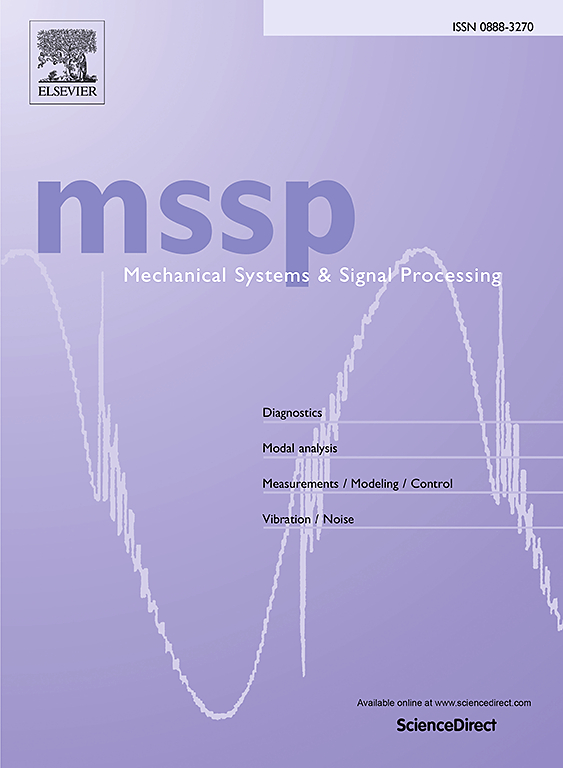Deep optical flow to identify structural vibration modal parameters
IF 7.9
1区 工程技术
Q1 ENGINEERING, MECHANICAL
引用次数: 0
Abstract
Accurate measurement of vibration signals is an important prerequisite for accurate analysis of structural vibration modes. Optical flow estimation is suitable for non-contact full-field signal measurement. However, optical flow datasets are usually synthesized by computers and lack practical application in engineering structures. In addition, the algorithm has deficiencies in processing sparse textures and edge features, and the sub-pixel estimation accuracy needs to be improved. Therefore, this paper constructs real structural vibration optical flow datasets to provide basic data support for structural health monitoring. For the deep optical flow algorithm, an adaptive Gabor filter component is proposed. By dynamically adjusting the direction and scale, the edge and texture features in the optical flow field are enhanced, and the fusion with the convolutional neural network further models the relationship between global and local features. At the same time, the local similarity matching mechanism is combined to improve the accuracy of optical flow estimation and the ability to identify local details. In addition, the smoothing term and the loss function of the learnable parameters are added to improve the physical consistency and prediction accuracy of the model, and effectively suppress the generation of noise interference and discontinuous optical flow. The results of qualitative and quantitative scene and ablation experiments show that the proposed deep optical flow algorithm is superior to the existing methods in terms of optical flow estimation accuracy, structural edge preservation ability and low light adaptability, and shows excellent performance in sparse texture scenes and low signal-to-noise ratio environments. In addition, by performing modal frequency error evaluation and energy ratio analysis on the identification results, the effectiveness and stability of the proposed method in modal main frequency identification and high-order mode extraction are demonstrated, providing a high-precision solution for non-contact modal analysis.
深光流识别结构振动模态参数
振动信号的准确测量是结构振动模态准确分析的重要前提。光流估计适用于非接触式全场信号测量。然而,光流数据集通常是由计算机合成的,在工程结构中缺乏实际应用。此外,该算法在处理稀疏纹理和边缘特征方面存在不足,亚像素估计精度有待提高。为此,本文构建了真实结构振动光流数据集,为结构健康监测提供基础数据支持。对于深光流算法,提出了一种自适应Gabor滤波器组件。通过动态调整方向和尺度,增强光流场的边缘和纹理特征,并与卷积神经网络融合进一步建模全局特征和局部特征之间的关系。同时,结合局部相似度匹配机制,提高了光流估计的精度和局部细节的识别能力。此外,增加了可学习参数的平滑项和损失函数,提高了模型的物理一致性和预测精度,有效抑制了噪声干扰和不连续光流的产生。定性和定量场景和烧蚀实验结果表明,本文提出的深度光流算法在光流估计精度、结构边缘保持能力和低光适应性方面优于现有方法,并在稀疏纹理场景和低信噪比环境中表现出优异的性能。此外,通过对辨识结果进行模态频率误差评估和能量比分析,验证了该方法在模态主频率识别和高阶模态提取方面的有效性和稳定性,为非接触模态分析提供了高精度解决方案。
本文章由计算机程序翻译,如有差异,请以英文原文为准。
求助全文
约1分钟内获得全文
求助全文
来源期刊

Mechanical Systems and Signal Processing
工程技术-工程:机械
CiteScore
14.80
自引率
13.10%
发文量
1183
审稿时长
5.4 months
期刊介绍:
Journal Name: Mechanical Systems and Signal Processing (MSSP)
Interdisciplinary Focus:
Mechanical, Aerospace, and Civil Engineering
Purpose:Reporting scientific advancements of the highest quality
Arising from new techniques in sensing, instrumentation, signal processing, modelling, and control of dynamic systems
 求助内容:
求助内容: 应助结果提醒方式:
应助结果提醒方式:


